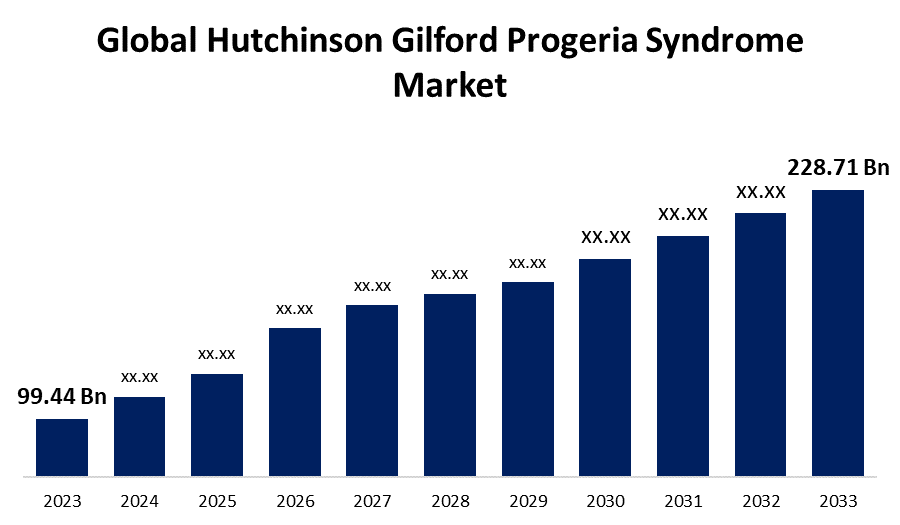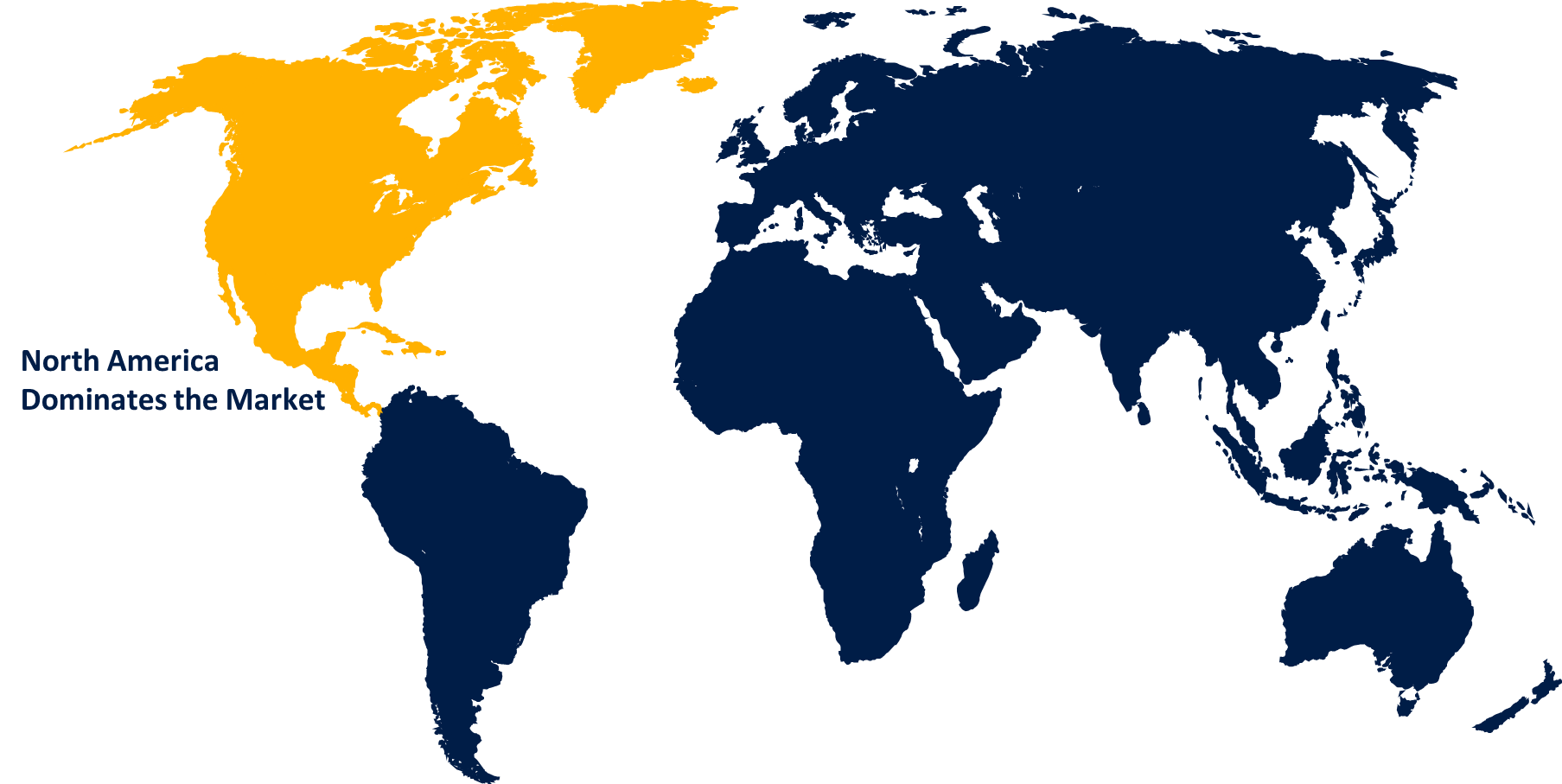Global Hutchinson Gilford Progeria Syndrome Market Size, Share, and COVID-19 Impact Analysis, By Route of Administration (Oral and Injectable), By Treatment (Medications, Gene Therapy, Supportive Care, and Cardiovascular Management), By End-User (Hospitals, Specialty Clinics, and Research Institutes), and By Region (North America, Europe, Asia-Pacific, Latin America, Middle East, and Africa), Analysis and Forecast 2023 - 2033.
Industry: HealthcareGlobal Hutchinson Gilford Progeria Syndrome Market Insights Forecasts to 2033
- The Global Hutchinson Gilford Progeria Syndrome Market Size was Valued at USD 99.44 Billion in 2023
- The Market Size is Growing at a CAGR of 8.69% from 2023 to 2033
- The Worldwide Hutchinson-Gilford Progeria Syndrome Market Size is Expected to Reach USD 228.71 Billion by 2033
- Asia Pacific is Expected to Grow the fastest during the forecast period.

Get more details on this report -
The Global Hutchinson Gilford Progeria Syndrome Market Size is Anticipated to Exceed USD 228.71 Billion by 2033, Growing at a CAGR of 8.69% from 2023 to 2033.
Market Overview
Hutchinson-Gilford progeria syndrome (HGPS) which is also referred to as "Benjamin Button disease" is a rare genetic disorder characterized by accelerated aging in children, caused by a mutation in the LMNA gene. This mutation produces an abnormal protein called progerin, which disrupts normal cell function, resulting in rapid aging symptoms such as growth delays, hair loss, skin thinning, joint stiffness, and cardiovascular complications. Children with HGPS typically have a shortened lifespan, often succumbing to heart disease in their early teens. The contributing factors for the Hutchinson-Gilford progeria syndrome market consist of increasing research on genetic disorders, the development of innovative therapies like farnesyltransferase inhibitors (FTIs) to reduce progerin buildup, and a growing focus on gene therapies. Rising awareness of HGPS disease among healthcare professionals and patients, coupled with funding from governments and rare disease organizations, supports market growth.
Report Coverage
This research report categorizes the market for the global Hutchinson Gilford progeria syndrome market based on various segments and regions forecasts revenue growth and analyzes trends in each submarket. The report analyses the key growth drivers, opportunities, and challenges influencing the global Hutchinson Gilford progeria syndrome market. Recent market developments and competitive strategies such as expansion, product launch, and development, partnership, merger, and acquisition have been included to draw the competitive landscape in the market. The report strategically identifies and profiles the key market players and analyses their core competencies in each sub-segment of the global Hutchinson-Gilford progeria syndrome market.
Global Hutchinson Gilford Progeria Syndrome Market Report Coverage
| Report Coverage | Details |
|---|---|
| Base Year: | 2023 |
| Market Size in 2023: | USD 99.44 Billion |
| Forecast Period: | 2023 - 2033 |
| Forecast Period CAGR 2023 - 2033 : | 8.69% |
| 2033 Value Projection: | USD 228.71 Billion |
| Historical Data for: | 2019-2022 |
| No. of Pages: | 254 |
| Tables, Charts & Figures: | 110 |
| Segments covered: | By Route of Administration, By Treatment , By End-User, By Region |
| Companies covered:: | Eli Lilly and Company, Bristol-Myers Squibb, Novartis AG, Sanofi, Pfizer Inc., AstraZeneca, Sarepta Therapeutics, Viking Therapeutics, Regeneron Pharmaceuticals, Horizon Therapeutics, Catalyst Pharmaceuticals, Solid Biosciences, AAVantgarde Bio, Regenxbio, Progenitor Cell Therapy, LLC, and Others |
| Pitfalls & Challenges: | Covid 19 Impact Challanges, Future, Growth and Analysis |
Get more details on this report -
Driving Factors
Hutchinson-Gilford Progeria Syndrome (HGPS) is driven by genetic research advancements and targeted therapies like farnesyltransferase inhibitors. Increased awareness, early diagnosis, and funding from rare disease organizations are boosting research efforts. Clinical trials, gene therapies, and improved treatment protocols support market growth. Patient advocacy and collaboration between medical professionals, researchers, and pharmaceutical companies enhance treatment accessibility and innovation.
Restraining Factors
Hutchinson-Gilford Progeria Syndrome (HGPS) is a rare and costly disease with limited treatment availability and healthcare infrastructure in low-income countries. This hinders patient population growth, reduces financial incentives for pharmaceutical companies, and slows advancements in therapeutic solutions, exacerbated by regulatory hurdles.
Market Segmentation
The global Hutchinson Gilford progeria syndrome market share is classified into route of administration, treatment, and end-user.
- The injectable segment is expected to hold the largest share of the global Hutchinson Gilford progeria syndrome market during the forecast period.
Based on the route of administration, the global Hutchinson Gilford progeria syndrome market is divided into oral and injectable. Among these, the injectable segment is expected to hold the largest share of the global Hutchinson Gilford progeria syndrome market during the forecast period. The injectable segment in the Hutchinson-Gilford progeria syndrome (HGPS) market is expected to grow due to advancements in biological and gene therapies that are primarily administered through injections. These treatments target the root cause of the disease by addressing progerin buildup which is the main cause of accelerated aging in HGPS patients. As research progresses and innovative therapies advance, demand for injectables is expected to increase.
- The gene therapy segment is expected to grow at the fastest CAGR in the global Hutchinson Gilford progeria syndrome market during the forecast period.
Based on the treatment, the global Hutchinson Gilford progeria syndrome market is divided into medications, gene therapy, supportive care, and cardiovascular management. Among these, the gene therapy segment is expected to grow at the fastest CAGR in the global Hutchinson Gilford progeria syndrome market during the forecast period. The gene therapy segment is expected to experience significant growth in the Hutchinson-Gilford progeria syndrome (HGPS) market due to its potential to target genetic mutations that provide a potential cure. Research and clinical trials are focusing on CRISPR and other gene-editing technologies, with the adoption expected to rise as therapies demonstrate efficacy. Increased investment from biotech companies, government initiatives, and rare disease organizations supports this growth.
- The specialty clinics segment is expected to grow at the fastest CAGR in the global Hutchinson Gilford progeria syndrome market during the forecast period.
Based on the end-user, the global Hutchinson Gilford progeria syndrome market is divided into hospitals, specialty clinics, and research institutes. Among these, the specialty clinics segment is expected to grow at the fastest CAGR in the global Hutchinson Gilford progeria syndrome market during the forecast period. The specialty clinics segment is expected to grow in the Hutchinson-Gilford progeria syndrome (HGPS) market, offering specialized care and advanced diagnostic tools. These clinics, equipped with multidisciplinary teams, provide personalized treatment plans and precise management for HGPS patients. As awareness of the condition increases and innovative treatments become available, patients and families increasingly turn to specialty clinics for comprehensive care.
Regional Segment Analysis of the Global Hutchinson Gilford Progeria Syndrome Market
- North America (U.S., Canada, Mexico)
- Europe (Germany, France, U.K., Italy, Spain, Rest of Europe)
- Asia-Pacific (China, Japan, India, Rest of APAC)
- South America (Brazil and the Rest of South America)
- The Middle East and Africa (UAE, South Africa, Rest of MEA)
North America is anticipated to hold the largest share of the global Hutchinson Gilford progeria syndrome market over the predicted timeframe.

Get more details on this report -
North America is anticipated to hold the largest share of the global Hutchinson Gilford progeria syndrome market over the predicted timeframe. The region is expected to dominate the global Hutchinson-Gilford Progeria Syndrome (HGPS) market due to advanced healthcare infrastructure, research, and early therapy adoption. The US, with numerous clinical trials and biopharmaceutical companies, plays a crucial role. Increased government funding, strong advocacy, and advanced diagnostic tools support its market share.
Asia Pacific is expected to grow at the fastest pace in the global Hutchinson Gilford progeria syndrome market during the forecast period. The Asia-Pacific region is expected to experience the fastest growth in the global Hutchinson-Gilford Progeria Syndrome (HGPS) market due to increased healthcare investments, increased awareness of rare genetic disorders, and improved diagnostic capabilities in countries like China, Japan, and India. Clinical research and development efforts, collaborations between local institutions and global pharmaceutical companies, government initiatives, and expanded healthcare infrastructure are also driving this growth.
Competitive Analysis:
The report offers the appropriate analysis of the key organizations/companies involved within the global Hutchinson Gilford progeria syndrome market along with a comparative evaluation primarily based on their product offering, business overviews, geographic presence, enterprise strategies, segment market share, and SWOT analysis. The report also provides an elaborative analysis focusing on the current news and developments of the companies, which includes product development, innovations, joint ventures, partnerships, mergers & acquisitions, strategic alliances, and others. This allows for the evaluation of the overall competition within the market.
List of Key Companies
- Eli Lilly and Company
- Bristol-Myers Squibb
- Novartis AG
- Sanofi
- Pfizer Inc.
- AstraZeneca
- Sarepta Therapeutics
- Viking Therapeutics
- Regeneron Pharmaceuticals
- Horizon Therapeutics
- Catalyst Pharmaceuticals
- Solid Biosciences
- AAVantgarde Bio
- Regenxbio
- Progenitor Cell Therapy, LLC
- Others
Key Target Audience
- Market Players
- Investors
- End-users
- Government Authorities
- Consulting And Research Firm
- Venture capitalists
- Value-Added Resellers (VARs)
Recent Developments
- In November 2020, The Progeria Research Foundation received FDA approval for Zokinvy (lonafarnib) for treating Progeria and processing-deficient Progeroid Laminopathies (PL).
Market Segment
This study forecasts revenue at global, regional, and country levels from 2020 to 2033. Spherical Insights has segmented the global Hutchinson Gilford progeria syndrome market based on the below-mentioned segments:
Global Hutchinson Gilford Progeria Syndrome Market, By Route of Administration
- Oral
- Injectable
Global Hutchinson Gilford Progeria Syndrome Market, By Treatment
- Medications
- Gene Therapy
- Supportive Care
- Cardiovascular Management
Global Hutchinson Gilford Progeria Syndrome Market, By End-User
- Hospitals
- Specialty Clinics
- Research Institutes
Global Hutchinson Gilford Progeria Syndrome Market, Regional
- North America
- US
- Canada
- Mexico
- Europe
- Germany
- UK
- France
- Italy
- Spain
- Russia
- Rest of Europe
- Asia Pacific
- China
- Japan
- India
- South Korea
- Australia
- Rest of Asia Pacific
- South America
- Brazil
- Argentina
- Rest of South America
- Middle East & Africa
- UAE
- Saudi Arabia
- Qatar
- South Africa
- Rest of the Middle East & Africa
Frequently Asked Questions (FAQ)
-
1. Which are the key companies that are currently operating within the market?Eli Lilly and Company, Bristol-Myers Squibb, Novartis AG, Sanofi, Pfizer Inc., AstraZeneca, Sarepta Therapeutics, Viking Therapeutics, Regeneron Pharmaceuticals, Horizon Therapeutics, Catalyst Pharmaceuticals, Solid Biosciences, AAVantgarde Bio, Regenxbio, Progenitor Cell Therapy, LLC, and Others.
-
2. What is the size of the global Hutchinson-Gilford progeria syndrome market?The Global Hutchinson Gilford progeria syndrome Market is expected to grow from USD 99.44 Billion in 2023 to USD 228.71 Billion by 2033, at a CAGR of 8.69% during the forecast period 2023-2033.
-
3. Which region is holding the largest share of the market?North America is anticipated to hold the largest share of the global Hutchinson Gilford progeria syndrome market over the predicted timeframe.
Need help to buy this report?